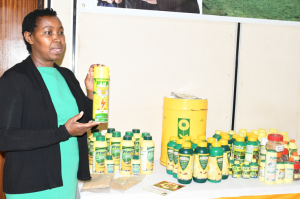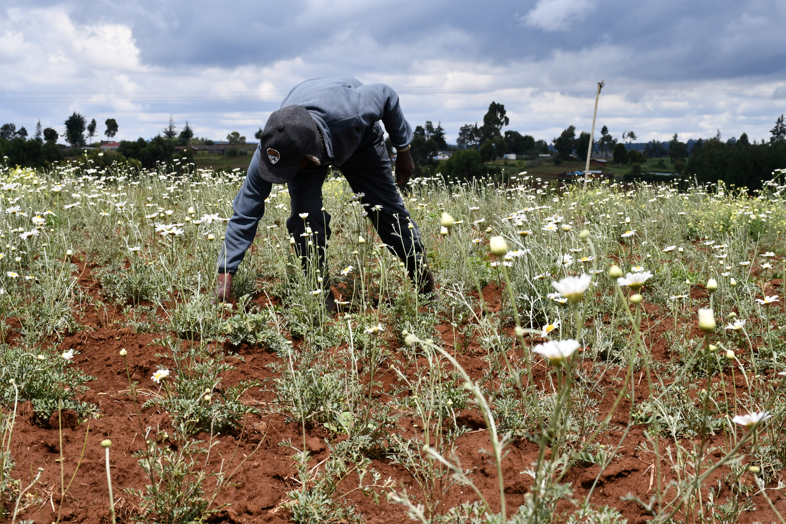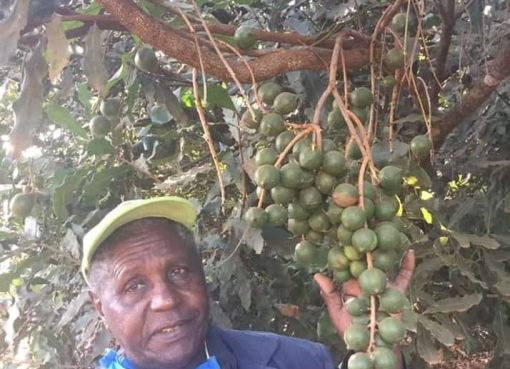White dazzling petals, with yellow anthers sunken in the middle, brightened by the cool climatic conditions of Kenyan highlands that they bask in. The pyrethrum flowers may pass for your ordinary bush flower, until their anthers assume a bulging middle.
The land on which the cool green leaves supporting the flowers rest is clean and free from pests, a sign that the flowers are not your ordinary flowers that would attract insects to aid in the pollination process. They are ‘deadly on the dudus, but gently on you’.
Despite the small portions of land under the pyrethrum crop, the recently revived sector is turning tables for farmers in Nakuru County, both for those planting the crop and those seeking organic solutions for perennial infestation by worms and pests for other crops as well as livestock.
“I have increased my portions of land under pyrethrum to two and a half acres which I harvest every two weeks translating to about 60 kilogrammes of dry flowers for every acre,” notes Joseph Sirma, a farmer at Sirikwa location in Molo Sub County.
Sirma is glad that unlike other crops that are expensive to manage, pyrethrum only demanded weeding and periodic harvesting to ensure the quality of the flowers is maintained for best returns.
Another farmer, Margaret Kiptanui, at Tangi in the same location prides in the revival of the crop that affords her 90 kilograms of the flowers every harvest on her one and a half acre piece of land.
“With the revival of this crop, I am assured of Shs.27, 000 paid upfront to my account that comes in handy when educating my children and attending to my needs. Pyrethrum pays more than potatoes and maize that I have been growing,” added Mrs. Kiptanui.
Kiptanui, who prides in upfront payment on delivery of dry flowers to collectors, calls on other farmers in highland zones of Kenya to grow the crop that is now on high demand following the liberalization of the sector in 2013.
Peter Omari, who manages 22.5 acres under the crop in Kuresoi North is certain that the crop was a game changer in the lives of small scale farmers.
“We have seedlings in the nursery that we are transplanting to 15 more acres, with more available for sale to farmers who are willing to start up this venture,” notes Omari, estimating to reach farmers up to 30 more acres.
The pyrethrum crop was first introduced to the country in 1928 with Kenya commanding up to 70 percent of the international market for pyrethrin, which is an extract of the pyrethrum flowers used in making insecticides and other public health products.
Under the then Pyrethrum Board, more farmers enlisted to grow the crop that largely depended on the international market. The shift to cheap synthetic insecticides and pesticides led to the shrinking of the market, in 2006, occasioning huge losses as the glut exceeded the demand.
The threat that overproduction posed, was that even the excess poison was hazardous to dispose to the environment, and that necessitated the stop.
In 2013, the sector was revitalized through the liberalization of the market to allow even private producers and processors to join in and reap from the sector. The revival of the sector also prioritized the payment of farmers from Shs.150 to the current guaranteed minimum return of Shs.300 for every kilo of dry flowers delivered.
Pyrethrum Processing Company of Kenya (PPCK) Production Manager, Carolyne Imbwaga, notes that the crop is planted for its Pyrethrins found in pyrethrum flowers. Pyrethin is an active ingredient used to produce organic based insecticides.
“Pyrethrum is propagated by seed or vegetative materials starting from tissue culture that produces disease free planting materials with ability to produce high yield of flowers with high pyrethrin content.
The country prides in 19 counties like Uasin Gichu, Nyandarua, West Pokot, Kisii, Nyamira among others, with the potential of alleviating poverty and improving the standards of its producers.
“We have 14 recommended commercial clones of pyrethrum with high flower yields recommended for the various pyrethrum growing ecological zones. These are Kenyan highlands that range from 1700m to 2800m above sea level, with minimum rainfall of 1000mm, well spread across the year.
Kenya competes with Tasmania in Australia, China, Rwanda and Tanzania, with Tasmania now taking lead in the supply of the world’s pyrethrin, having recently overtaken Kenya.
“The revival strategy targets to increase the acreage under pyrethrum to 80, 000 acres by 2027 from the current 6, 000 acres. Kenya, at its peak, is able to produce over 20 metric tonnes of pyrethrin and there is need to invest more in the high quality planting materials, which are available in small quantities at PPCK,” says Imbwaga, adding that the company recorded 310 metric tonnes of the produce in 2023.
The four-year-season crop starts yielding three months after transplanting, with farmers being able to break even in a year after planting. The crop is cut back every year, on the onset of rains, to allow fresh shoots and better yields.
Field officers stationed at various sub-county offices, she adds, help train farmers on agronomic aspects of crop production including managing nurseries for the seeds, to land preparation, picking, drying and delivery of flowers.
“Farmers are paid Shs.300 upfront on delivery of every kilo of dried flowers to the Nakuru based processing company, with more paid for the percentage of pyrethrin content in the flowers after an analysis is done,” adds Imbwaga, urging farmers to improve the quality of their produce to earn up to Shs.750 for every kilogramme delivered.
The crop, she says, has the potential of increasing the farmers income up to Shs.6 Billion, with a foreigh exchange of up to Shs.9 billion annually.

“From land preparation, growing of the crop, harvesting and transportation value chain, the crop is able to support upwards of 5 million Kenyans if the crop is well established, maintained and supported across the value chain,” adds Imbwaga.
Pyrethrum growing has continued to take shape in the country, with farmers being urged to take advantage of the processing in the country to meet the demand for pyrethrin products across the world.
Pyrethrum products, that range from aerosol sprays, pesticides and other insecticides as well as animal feeds, are best preferred because they immediately degrade and hence best suited for food safety.
Caroline Koech, the Product Development Manager at PPCK, notes that pyrethrum’s wide spectrum was acceptable for use in making of Botanical insecticide, that were value added products being sold both locally and globally.
“Pyrethrin being a natural molecule has six distinct insecticidal properties that makes it unique, coupled with its environmental friendly properties as it is easily biodegradable and safe on humans and animals.
“We have products for control of mosquitos, bedbugs, cockroaches and tick and tsetse flies in animals. These products are safe for use in homes, manufacturing industries and food handling premises.
“Pyrethrum is also recommended as a pesticide with a pre-harvest interval of a day, which makes it suitable for those in the horticulture export market as they have no pesticides residues,” added Koech, noting that Pymac product controlled maize stock borers, that was a nuisance in the maize growing regions.
Koech added that affordable Pymac had good quantities of proteins and carbohydrates that come in handy as an animal feed. The company is in the process of rolling out more products as well as enlisting distributors.
By Anne Sabuni





